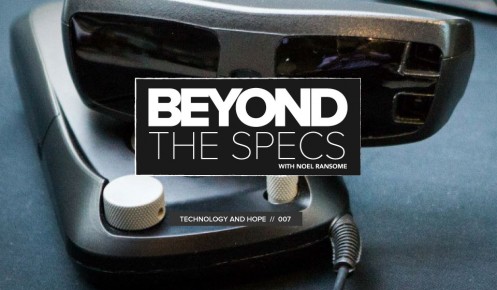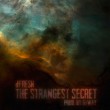For a long time now I’ve been struggling with the tedium of writing about technology. It was never for a lack of available news, but for its ironic sense of sameness. This industry has always been about a constant mode of change, yet sometimes the scene seems to be static in its commerce driven sectors. Bigger screens, curved displays, 4K resolutions, smart watches, smart fridges – blah, blah, blah, blah. Sellable tech suddenly becomes defined by its trends, and the mania over dollar sign domination stifles the imagination, limiting human invention.
The novelty that drove an industry based on advancement was beginning to wear thin, until I spoke to an individual like Taylor West, director of marketing and communications over at eSights.
I began to question the practical use of having a few million more pixels in a television set or whether it was at all necessary for a fridge to have a built-in Twitter app. The novelty that drove an industry based on advancement was beginning to wear thin, until I spoke to an individual like Taylor West, director of marketing and communications over at eSights.
“Every day, everything we do at work helps people change their lives for the better,” says West. “It helps people see their family again, or get a job for the first time, or have these incredible moments they wouldn’t otherwise get to have. It makes coming into the office very, very easy for everyone involved.”
He continues to speak with me in a hurried tone, as if he were on the move. “Honestly, it was a bit of a fluke that I even saw your e-mail,” he says. During the past week, his team had received 10,000 e-mails about a new form of technology that was just beginning to hit its social media stride.
It was a YouTube video emerged overnight titled “Blind woman sees her son for the first time” that kick started a mania for the small start-up company with offices in Ottawa and Toronto. It showcased a Guelph woman named Kathy Beitz who had never seen her baby (or any baby for that matter) before. She was diagnosed with Stargardt disease when she was 11 and had developed a blind spot in the centre of her field of vision – essentially she was legally blind.
Simultaneously awestruck over the sight of her newborn child while playing with his tiny toes, she appears like a specimen for something once considered science fiction, now turned science fact. With a dark visor that appeared to be a cross between a bulky pair of 3D glasses and a form of tech that would make Star Trek’s Geordi La Forge nod in approval, it resembled something exciting – a brave new world. The three million plus views it generated was evidence of that.
The research behind the device referred to as the eSight goes back about eight years and was created by Conrad Lewis, a Canadian technology entrepreneur who had two sisters who were legally blind. His thought process was to use his technical knowledge and skills to produce a device that could change the world.
“When it came to eSight and my sisters’ eye problem… I said I’m starting to whine now about this problem,” says Conrad Lewis in a promotional video about his product. “Stop whining and solve the problem, fix it yourself, and it’s your sister so you have to fix it for her.”
“eSight as a company in some sense really comes out from a labour of love,” says West. “… The premise behind eSight is if you can increase the information that can get to the eye, you’re going to be able to help that person see more.”
In the headwear there is a camera that constantly captures high definition video being simultaneously enhanced with certain software algorithms that serve to improve the image. The video in question specifically becomes tailored to the legally blind in ways that can help them receive more information visually. It’s the sort of jump in aesthetic stimulation that could allow Kathy Beitz who had just two per cent of her vision left to be able to make out facial and physical features.
Before speaking to West, I, of course, wanted to know if this was actually a new form of technology. I’ve been led to believe that quite a few juggernauts of world-changing tech were firsts in line (Apple, I’m looking at you).
Before speaking to West, I, of course, wanted to know if this was actually a new form of technology. I’ve been led to believe that quite a few juggernauts of world-changing tech were firsts in line (Apple, I’m looking at you). The reality is that while similar ideas had been worked on by prestigious American-based institutions, eSight has uniquely managed to take a giant leap forward by offering a product that actually works, minus the limitations. (eSight’s only limitation: it is not fit for someone 100 per cent blind.)
“A lot of what we do is actually software, so we really hit a group of algorithms that trigger a very strong reaction with people,” says West. “The way eSight eyewear is worn, it actually doesn’t cut off your peripheral vision so it’s a totally mobile technology. Unlike other devices that came before us, you can wear eSight eyewear as you walk around and that’s really the crucial differentiator… if there’s any delay between how they move and what they see, it can be very disorientating, but we’ve managed to achieve no perceptible delay… That was a huge engineering challenge.”
It wouldn’t be a surprise for such a new technology to be costly at first of course. Coming in at around $15,000 per headset, it’s one of those rare occasions when dollar signs associated with a piece of tech is more than justified, as West made clear to me.
At this point in the conversation, I’m reminded of why I love the tech scene in the first place. Yes, it serves as entertainment, digitized stress relief and the like, which is all well and good. But it can also enhance human life.
“That’s where our fundraising program comes from,” he explains. “We don’t believe that cost should be a reason people don’t access technology. So on an individual basis, we do the best we can to match people with a wide variety of funding programs that make sense for them so they can get the glasses.”
At this point in the conversation, I’m reminded of why I love the tech scene in the first place. Yes, it serves as entertainment, digitized stress relief and the like, which is all well and good. But it can also enhance human life, if it’s where the world’s inventors choose to place a focus – an endeavour that needs just as much coverage as the next HD television set.
“I just want to emphasize that the response isn’t just coming from the low-vision community,” says West. “We have so many people with typical eyesight learn about Kathy and offer to pitch in, in some way, to help other people who have low vision get this life-changing technology. It not only provides a lot of hope to the people who work at eSight, I know that our many users are also overjoyed to see this groundswell to help people like them.”
@NoelRansome




Comments are closed.